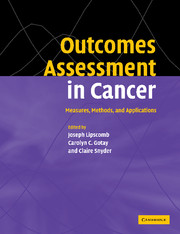Book contents
- Frontmatter
- Contents
- List of contributors
- Acknowledgments
- 1 Introduction to Outcomes Assessment in Cancer
- Health-related quality of life in cancer: general concepts and generic measures
- Assessing health-related quality of life during treatment
- Assessing health-related quality of life across the cancer continuum
- Measuring the experience and needs of cancer patients and caregivers
- Methodological considerations in applications to cancer outcomes research
- Modern psychometric theory in cancer outcomes research
- Assessing the economic impact of cancer
- Research and policy implications
- Invited papers
- Invited Paper A The world of outcomes research: yesterday, today, and tomorrow
- Invited Paper B The ten Ds of health outcomes measurement for the twenty-first century
- Invited Paper C The use of cognitive interviewing techniques in quality of life and patient-reported outcomes assessment
- Invited Paper D Industry perspective regarding outcomes research in oncology
- Index
- References
Invited Paper D Industry perspective regarding outcomes research in oncology
Published online by Cambridge University Press: 18 December 2009
- Frontmatter
- Contents
- List of contributors
- Acknowledgments
- 1 Introduction to Outcomes Assessment in Cancer
- Health-related quality of life in cancer: general concepts and generic measures
- Assessing health-related quality of life during treatment
- Assessing health-related quality of life across the cancer continuum
- Measuring the experience and needs of cancer patients and caregivers
- Methodological considerations in applications to cancer outcomes research
- Modern psychometric theory in cancer outcomes research
- Assessing the economic impact of cancer
- Research and policy implications
- Invited papers
- Invited Paper A The world of outcomes research: yesterday, today, and tomorrow
- Invited Paper B The ten Ds of health outcomes measurement for the twenty-first century
- Invited Paper C The use of cognitive interviewing techniques in quality of life and patient-reported outcomes assessment
- Invited Paper D Industry perspective regarding outcomes research in oncology
- Index
- References
Summary
Introduction
The goal of treatment for many persons with cancer is not cure but improvement or maintenance of functioning and well-being during their remaining period of life. This is particularly true for patients with advanced or metastatic cancers. Trials to produce evidence of effectiveness or for regulatory approval may include patient assessments of benefit as well as classical clinical endpoints used in oncology settings. These patient assessments of treatment benefit may or may not be related to the traditional measures of treatment success such as survival, tumor shrinkage, or time to tumor progression. For this reason, additional outcome measures to estimate benefit or risk/benefit trade-offs have been developed. Outcomes measures in this category of health assessment are referred to as patient-reported outcomes (PROs) because they are used to collect data directly from the patient.
It is increasingly recognized that the patient's perspective is unique and represents a valuable contribution to drug evaluation and treatment processes. This is particularly important when studying the effects of treatments on cancer symptoms such as pain and fatigue, outcomes not accurately measured by observers. Recent changes in the health care system have greatly empowered patients who are now considered partners rather than passive consumers. To maximize their contribution, they need to be informed about the outcomes associated with treatment. Patients are not always concerned with the same questions as treating physicians or clinical researchers.
- Type
- Chapter
- Information
- Outcomes Assessment in CancerMeasures, Methods and Applications, pp. 623 - 638Publisher: Cambridge University PressPrint publication year: 2004



